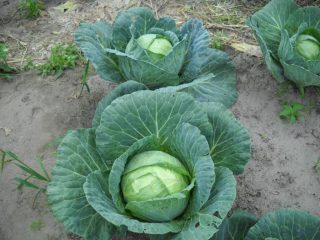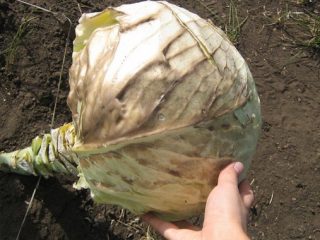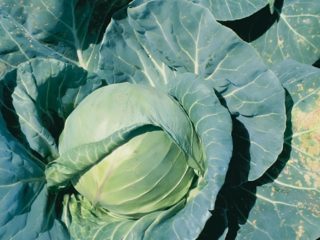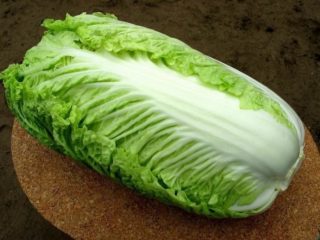Content
Savoy cabbage is much less popular among gardeners than white cabbage, although in all respects it is a serious “competitor”. Its advantages include not only its original appearance and outstanding taste, but also its general ease of care, cold resistance, and good immunity. Even inexperienced gardeners can grow Savoy cabbage in open ground. Although there are certain nuances of agricultural technology and important points in preparation, which are recommended to be studied in advance.
When to plant savoy cabbage in open ground
Cultivation is possible either by sowing seeds directly into the garden bed or by pre-cultivating seedlings at home. The first option is practiced if the climate in the region allows: in Russia it is suitable for gardeners in the North Caucasus, the Black Sea region, Crimea, Kuban, and the south of the Volga region.
Seedlings
When grown in open ground by seedlings, seedlings of early and mid-early Savoy cabbage are transferred to the garden bed at the age of 45-50 days.Mid- and late-ripening varieties or hybrids are planted a little earlier - 35-45 days after seed germination.
Accordingly, the timing of sowing seedlings varies depending on the length of the growing season:
- early - second ten days of March;
- mid-season - the last days of March or the very beginning of April;
- late - first ten days of April.
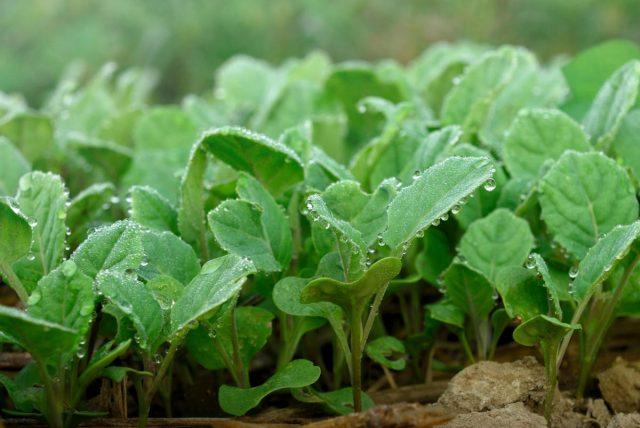
Adult seedlings have 5-6 true leaves
Seeds
When sown in open ground, Savoy cabbage seeds survive and germinate at temperatures of only 3-5 °C. However, for normal development they need higher temperatures - 15-20 °C.
In southern Russia, the air warms up sufficiently around mid-April. Accordingly, seed sowing occurs in the second decade of this month. However, you can start growing a little earlier if it is possible to cover the bed with black plastic film.
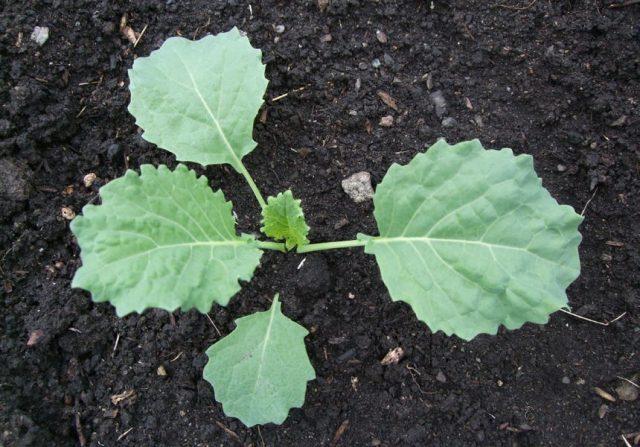
It takes 6-14 days for seedlings to emerge from seeds when sown directly into the garden bed.
How to grow Savoy cabbage in open ground from seeds
Growing Savoy cabbage from seeds in open ground generally follows the same algorithm as for the “classic” white cabbage. But there are important nuances that need to be studied and taken into account in order for the culture to “show itself” in the best possible way.
Site selection and preparation
When grown in open ground, the place where you can plant savoy cabbage is chosen taking into account the “requirements” of the crop:
- Good lighting. Savoy cabbage needs bright, but diffused light; it does not tolerate direct sunlight very well. The best place for growing it in open ground is on the slope of a gentle hill, oriented to the south or southeast.
- The presence at some distance of a “barrier” that does not create shade or impede aeration, but provides protection from strong winds and cold drafts.
- Quite fertile, but at the same time loose substrate. “Heavy” clay and peaty soils, and very “poor” sandy soils should be avoided.
- Neutral or close to it pH (6.5-7.0). When grown in an alkaline substrate, plants simply “refuse” to develop and form heads of cabbage; when grown in an acidic substrate, infection with clubroot is almost inevitable.
- Lack of groundwater approaching a meter or closer to the soil surface. When growing Savoy cabbage in open ground, stagnation of water at the roots is unacceptable, as this provokes the development of rot. For the same reason, lowlands and areas at the foot of hills, where rainwater and damp air stagnate for a long time, are not suitable for it.
- Compliance with crop rotation rules. After other plants from the Cruciferous family, growing Savoy cabbage in open ground is permissible after 3-5 years. Suitable “predecessors” would be legumes, pumpkin, nightshade (except tomatoes), spicy herbs, onions and garlic.
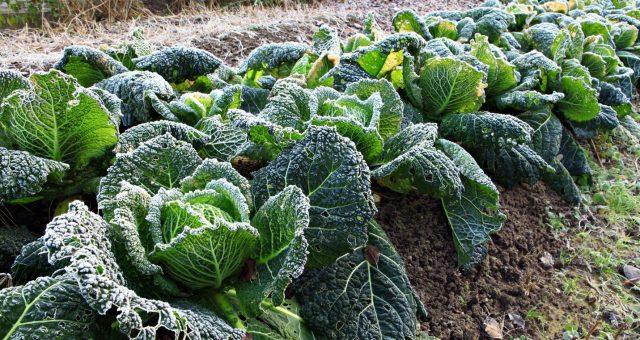
If there is a lack of light, the heads of cabbage will not set
The bulk of the site preparation work took place in the fall of last season. It needs to be dug up, while simultaneously getting rid of any debris, especially plant debris. In the process, the soil is “enriched” with humus or rotted compost (5-7 l/m²) and complex fertilizer is applied - universal or specifically for cabbage (25-40 g/m²).

It is advisable to use biofungicides to treat seeds before sowing, but this is not a mandatory requirement.
Seed preparation
Before sowing Savoy cabbage seeds in open ground, they undergo several stages of preparation:
- Visual inspection. It is better to immediately reject “suspicious” seeds, the appearance, shape or color of which clearly deviates from the norm.
- Germination test. To find out which seeds are suitable for growing, they are soaked in a saline solution. “Empty” specimens without an embryo are lighter, so they remain on the surface, while “full” ones “sink to the bottom” after a quarter of an hour.
- Disinfection. Necessary for the prevention of fungal diseases when growing Savoy cabbage in open ground. The seeds are “etched” in a solution of any fungicide. There are also folk remedies for disinfection - a solution of potassium permanganate (light pink), baking soda (1 tablespoon per liter of water), iodine (10 drops per liter).
- Biostimulation. Improves seed germination, stimulates the development of Savoy cabbage seedlings. In the future, such treatment has a positive effect on the overall yield and quality of heads of cabbage. A comparable effect is provided by both purchased drugs (Epin, Zircon, Heteroauxin) and folk remedies.
- Hardening. This is not a mandatory step, but this procedure also has a positive effect on seed germination. First, they are dipped in hot (45-50 °C) water for 15-20 minutes, then put in the refrigerator for a day.
Sowing scheme
The spaces between adjacent plants and the row spacing are determined based on the dimensions of the adult rosettes. But you can also focus on “average” intervals for varieties, taking into account the ripening time:
- early – 40*50 cm;
- mid-season – 50*60 cm;
- late – 60*70 cm.
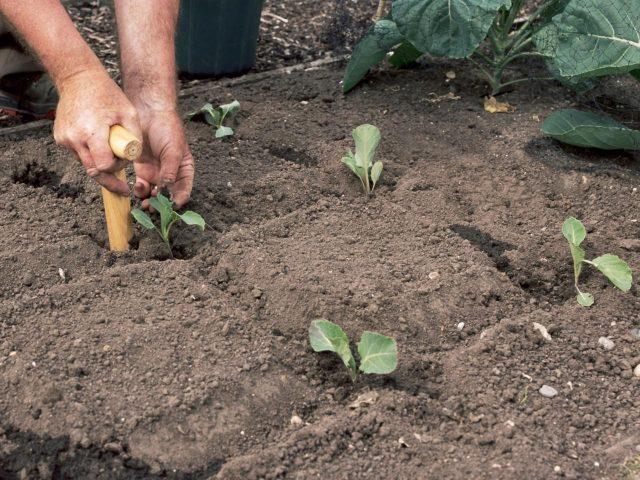
Typically, the planting scheme is recommended by the manufacturer on the seed package.
Aftercare
Despite the opinion of many gardeners, Savoy cabbage is quite unpretentious in care. It does not need any “additional” agrotechnical measures compared to white cabbage.
Watering
Savoy cabbage is moisture-loving, but it categorically does not tolerate “swamps” in the garden when grown in open ground. Before emergence, the substrate must be constantly maintained in a moderately moist state, not allowing it to dry out. Seedlings are watered often (every 2-3 days), but little by little.
When Savoy cabbage reaches the size of adult seedlings (height 15-17 cm and 5-6 true leaves), you can switch to weekly watering. The “norm” is increased to 13-15 l/m² of beds from 4-5 l/m².
Any watering method is suitable. The main thing is that water does not get on the leaves and especially in the center of the rosette. Otherwise, the development of rot or bacteriosis is almost inevitable.
When growing in open ground, the intervals between waterings must be adjusted according to the weather.
Feeding
For early and mid-early varieties or hybrids, two feedings per season are enough. For mid-season, their number increases to three, for mid-late and late - to four.
The fertilizer application scheme looks like this:
- 12-15 days after seed germination - nitrogen. It is advisable to use purchased mineral fertilizers rather than natural organic matter. The latter can easily “burn” the roots of the seedlings.
- After another three weeks, when the head of cabbage begins to form. Here, rosettes need complex fertilizers containing phosphorus and potassium, with a minimum of nitrogen. Both universal and specialized fertilizers are suitable. You can also use natural organic matter.
- After 2-2.5 weeks and in the second ten days of August. For the formation of heads of cabbage, mid-late and late varieties of Savoy cabbage when grown in open ground need phosphorus and potassium. Nitrogen in fertilizers must be avoided, otherwise nitrates will accumulate in the leaves.

Plants need nitrogen only in the early stages of development.
Treatment against diseases and pests
The immunity and general stamina of Savoy cabbage are relatively good compared to many other varieties. She also does not have any specific diseases or pests.
Therefore, to prevent the development of pathogenic microflora, it is often sufficient to treat seeds with fungicides before planting. If, when growing in open ground, the weather is favorable for the activation of fungi for a long time, folk remedies or preparations of biological origin are used at intervals of 7-15 days.
Do the same to protect Savoy cabbage from pests.When there is a massive “raid” of them on neighboring beds, to “preventively” repel insects, it is necessary to use folk remedies, as well as universal or specialized insecticides or other preparations.
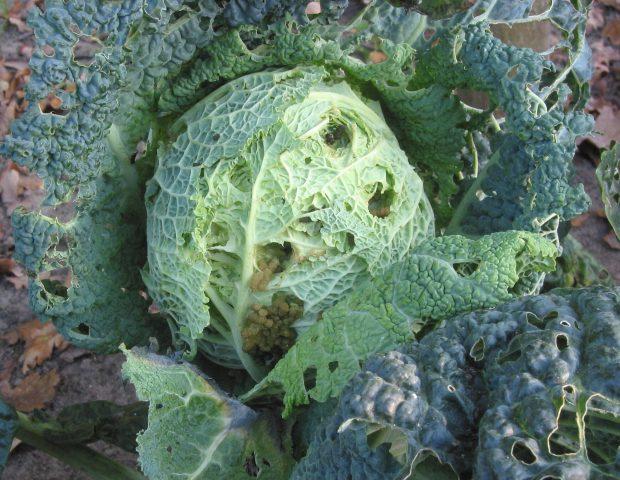
Prevention against diseases and pests is not required for Savoy cabbage during the entire period of cultivation in open ground.
Conclusion
Growing Savoy cabbage in open ground is practiced both by seedlings and by directly sowing seeds in a garden bed. Both options are not complicated, but if there is a choice, gardeners prefer the second - it requires less time and effort. To obtain the highest possible yields, it is necessary to choose the right place for the garden bed, prepare the soil and seeds, follow the planting scheme and provide the crop with quality care during the season.

